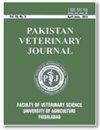H9N2型禽流感病毒神经氨酸酶突变分析提示家禽高致病性原因
IF 5.4
3区 农林科学
Q1 VETERINARY SCIENCES
引用次数: 4
摘要
接收:修订:接受:在线发布:2019年8月29日2019年12月27日2020年1月15日2020年2月10日H9N2是一种低致病性禽流感病毒,在全球家禽业中引起呼吸道感染。病毒神经氨酸酶(NA)具有唾液酸酶活性,在致病性中起着至关重要的作用。在本研究中,在拉合尔GP实验室从患病鸟类中分离出H9N2病毒。然后利用不同的生物信息学工具对病毒NA基因进行扩增、测序和分析。结果表明,与低致病性禽流感病毒相比,分离株的高致病性是由G127S和S450L突变引起的,它们是由A/partridge/Bistan/260/2015(H9N2)病毒进化而来。从鹧鸪病毒中分离出的鸡病毒的进化表明了其系统发育关系。我们分离株的高致病性归因于登录号为MH105293、MH105294和MH105295的分离株中的G127S、I192V、V307M和S450L氨基酸取代。尽管巴基斯坦家禽中的H9N2被认为是一种低致病性流感病毒,但我们目前的研究表明,它具有高致病性,死亡率>75%。利用SWISS MODEL软件构建了NA蛋白模型,该模型比野生型更稳定,能量分别为119kJ/mol和145kJ/mol。此外,G127S、I192V、V307M、S450L、D141N、V254I和V312I的位置具有显著的抗原变异性,以及影响蛋白质结构、功能和稳定性的β片多于α螺旋。这项研究将帮助家禽疫苗制造商设计定制的硅疫苗或神经氨酸酶抑制剂,以应对巴基斯坦当地家禽业因H9N2病毒感染而面临的挑战。©2020 PVJ。保留所有权利本文章由计算机程序翻译,如有差异,请以英文原文为准。
Mutational Analysis of Neuraminidase of Avian Influenza virus H9N2 Indicating the Cause of Hyper Pathogenicity in Poultry
Received: Revised: Accepted: Published online: August 29, 2019 December 27, 2019 January 15, 2020 February 10, 2020 H9N2 is a low pathogenic avian influenza virus that causes respiratory tract infection in poultry industry worldwide. Viral neuraminidase (NA) plays a vital role in pathogenicity due to its sialidase activity. In this study, H9N2 virus from diseased birds was isolated at GP laboratory, Lahore. Then viral NA gene was amplified, sequenced and analyzed using different bioinformatics tools. Results revealed that high pathogenicity of the isolated strains is due to G127S and S450L mutations in comparison to low pathogenic avian influenza virus and they have evolved from A/partridge/Pakistan/260/2015(H9N2) virus. The evolution of the isolated chicken virus from partridge virus shows its phylogenetic relationship. High pathogenicity of our isolates is attributed to the amino acid substitutions: G127S, I192V, V307M and S450L in the isolates with accession numbers MH105293, MH105294 & MH105295. Though H9N2 in Pakistani poultry is regarded as a low pathogenic influenza virus but our current study shows it to be highly pathogenic with high mortality >75%. By using SWISS MODEL software, NA protein model was also constructed, which is more stable than wild type with 119kJ/mol& 145kJ/mol energy values respectively. Furthermore, positions at G127S, I192V, V307M, S450L, D141N, V254I and V312I have significant antigenic variability, as well as more beta sheets than alpha helices affecting the protein structure, function and stability. This study will help the poultry vaccine manufacturers to design the customize in silico vaccine or neuraminidase inhibitors to meet the challenges arose in local poultry industry of Pakistan due to H9N2 viral infection. ©2020 PVJ. All rights reserved
求助全文
通过发布文献求助,成功后即可免费获取论文全文。
去求助
来源期刊

Pakistan Veterinary Journal
兽医-兽医学
CiteScore
4.20
自引率
13.00%
发文量
0
审稿时长
4-8 weeks
期刊介绍:
The Pakistan Veterinary Journal (Pak Vet J), a quarterly publication, is being published regularly since 1981 by the Faculty of Veterinary Science, University of Agriculture, Faisalabad, Pakistan. It publishes original research manuscripts and review articles on health and diseases of animals including its various aspects like pathology, microbiology, pharmacology, parasitology and its treatment. The “Pak Vet J” (www.pvj.com.pk) is included in Science Citation Index Expended and has got 1.217 impact factor in JCR 2017. Among Veterinary Science Journals of the world (136), “Pak Vet J” has been i) ranked at 75th position and ii) placed Q2 in Quartile in Category. The journal is read, abstracted and indexed internationally.
 求助内容:
求助内容: 应助结果提醒方式:
应助结果提醒方式:


